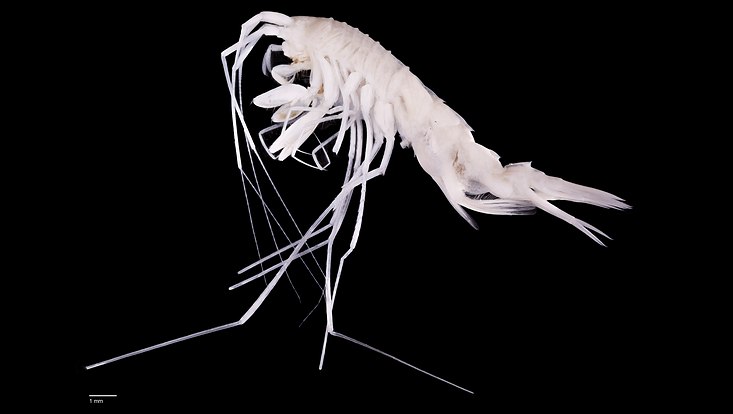
Treasure of the month December: A deep sea crab
4 December 2018

Photo: UHH/CeNak, Anne-Nina Lörz
This is it: the amphipod Rhachotropis saskia, named by Anne-Nina Lörz after her colleague Saskia Brix from the German Center for Marine Biodiversity Research.
It lives at ocean depths of over 8,000 meters. In freezing cold, total darkness, under enormous water pressure and with little food supply, the amphipod Rhachotropis saskia stalks over the sediment with its long, thin legs - when it is not swimming. Rhachotropis saskia is one of the few described Amphipoda (amphipods) of the Kuril-Kamchatka Trench in the northwestern Pacific Ocean and our treasure of the month December. The vast majority of amphipods in the hadal (ocean depth below 6,000 meters) are scavengers. Rhachotropis saskia, however, is an active hunter.
For a long time, Rhachotropis saskia, like its relatives, lived deep in hiding. Although several expeditions have led to the Kuril-Kamchatka Trench since the 1950s, a depth of 8,000 meters, i.e. Himalayan level, was inaccessible to researchers at the time. In recent years, however, scientists have used sophisticated technology to work their way to this depth on four international expeditions, including KuramBio I and II with the research vessel Sonne. Rhachotropis saskia is the eighth psyllid species to be described. CeNak scientist Anne-Nina Lörz recently named it after her colleague Saskia Brix of the German Center for Marine Biodiversity Research (DZMB).
In molecular and microscopic analyses, Anne-Nina Lörz found out a lot about the distinctive deep-sea flea crab. Most representatives of this species are over two centimeters long, which is quite large for a amphipod. Unlike most carrion- and sediment-eating amphipods, "her" eyeless amphipod goes hunting. The researcher found this out by examining some animals caught with prey in their mouths and claws - they had apparently just been disturbed during their meal.
Rhachotropis saskia was found both in depths of 8,200 meters of the Kuril-Kamchatka Trench, and in the abyssal (sea depth of 5000 meters) north and south of the trench. That is, this species has a huge vertical distribution range of more than 3,000 meters. "For us, this proves that the Kuril-Kamchatka Trench is not a barrier to their dispersal," Anne-Nina Lörz said in the journal PeerJ [https://peerj.com/articles/4887/].
The LIB scientist is currently continuing her research on Amphipoda as part of the DFG (German Research Foundation) funded Amphipoda Project of the international IceAGE Program (Icelandic Animals Genetics & Evolution) - but on those living around Iceland in the deep sea:
https://www.cenak.uni-hamburg.de/forschung/abteilungen/wirbellose2/aktuelles/2018-10-15-news.html.
